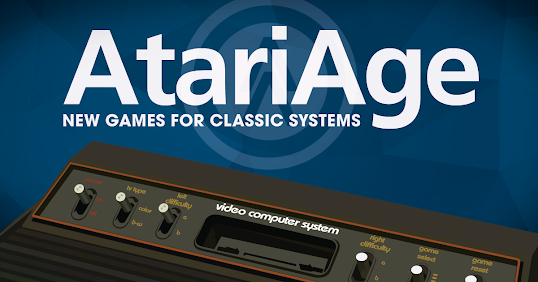Back in the golden age of video games, space shooters were incredibly popular in both the arcades and on home gaming consoles. Zapping aliens was an addiction for a whole generation of gamers, and as noted in my post on Dark Cavern, the arcade smash Space Invaders proved to be equally lucrative for Atari as their first "killer app" on the 2600 VCS. As a teenager and young adult, I enjoyed countless hours in dimly lit arcades blasting away at all forms of space menaces on cabinets such as Space Invaders, Defender and Galaga (to name just a few). So of course, when these games made their way to the home consoles I was thrilled. And now as a GenX adult who is an active retrogamer, I still always enjoy a good space game. This brings us to the 2600 title I'll be looking at here - the aptly titled Space Game.
In Space Game you control a ship armed with a photon blaster (also referred to as a cannon) used to destroy the different types of enemy Kraal who attack in packs of three at a time. In wave after wave, these invaders move in various patterns across the screen firing down on your ship. After a certain number of enemies are destroyed, there is a break in the battle where you navigate through a debris field. Unlike the lethal enemy fire, a collision here will not destroy your ship, but rather cost you points for each hit (while avoiding any collisions awards bonus points). After three waves of Kraal enemies are destroyed, you face off against a Mega Mutant who is more difficult to kill, but also worth more points for destroying. And finally, upon defeating the mutant, your ship travels through a wormhole towards the next battle. Like the debris field, each collision costs you points, while a clean pass through awards them.
Because it's human nature to look at any title and compare it to something that came previously, I'll first note that the game this reminded me most of is Megamania. That Activision classic also featured all sorts of odd-looking, colorful enemies (such as cookies and hamburgers) attacking in waves from above. But while it has all the old-school charm of such a classic Atari 2600 space shooter, the 32K in this enhanced title has allowed for quite a bit more to be added, and thus Space Game is very much its own unique game.
There are many aspects of this deceptively simple looking game that offer enough challenges to keep any dedicated retrogamer joyfully hitting that reset button time and again. First among them is the "alien technology" that appears sporadically upon destroying attackers. In more modern gaming terminology these would be called power-ups, and they do various good or bad (temporary) things to your ship upon contact. A couple examples are giving you wide photo blasts (good) and making the size of your ship wider (bad). So, this necessitates carefully studying the chart in the game manual in order to improve those split-second decisions on whether to let said technology impact your ship or not. (Yes, this is one of those games where one benefits from a thorough perusal of the manual before playing). This is another nice touch which definitely adds an extra layer to the already intense space battle, making employing strategy almost as important as having quick reflexes.
The difficulty level of this game increases at an even, steady pace, beginning with aliens which are fairly easy to destroy, and gradually moving on to faster enemies that are tougher to home in on (all of which also employ a "smart bomb", eerily reminiscent of that pesky "destroyer missile" in the classic Yar's Revenge). This is of course also affected by both the game variation chosen (there are three), and the difficulty switches, but I feel the difficulty ramps up at a reasonable rate that allows me to increase my skill level with each subsequent play. And skill is definitely needed when you reach the stages with enemies that can only be destroyed while they are not in motion, or when they are hit twice. The only exceptions to this reasonable pacing (so far) are the debris field and wormhole screens, which I've yet to get through without suffering numerous point-draining hits. But I'll definitely keep trying to improve...
The final thing I'd like to note is that the quality of the artwork and packaging are quite impressive (see photo of game cartridge and manual above). As chronicled in the most excellent coffee-table book Art of Atari, and experienced first-hand by us early gamers back in the day, Atari's unsung graphic artists did an excellent job with the product art. And this is also true here, with Space Game showcasing a downright creepy-looking alien on the glossy box, manual and cartridge. Kudos go out to Maggie Vogel for the excellent packaging design.
Overall, Space Game is a fun and challenging (enhanced memory) throwback to the early days of Atari space shooters which I'm sure will please many retrogaming fans, and perhaps a few modern gamers as well. It has colorful graphics and sounds, fast-paced gameplay, and is another shining example of the creativity and resourcefulness of the Atari homebrew community which I highly recommend adding to any retrogaming collection.






























